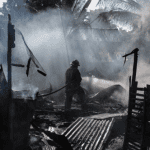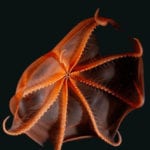 Mysteries
Mysteries  Mysteries
Mysteries  History
History 10 Surprising Stories About the Texas Rangers
 Humans
Humans 10 Philosophers Who Were Driven Mad by Their Own Theories
 Miscellaneous
Miscellaneous 10 Video-Game-Worthy Weapons and Armors from History
 Weird Stuff
Weird Stuff 10 Psychics Who Accurately Predicted Wartime Events
 The Arts
The Arts 10 Pieces of Art Inspired by a Broken Heart
 Health
Health 10 Science Fiction-Sounding New Medical Treatments
 History
History 10 Surprising Facts About the Father of Submarine Warfare
 Space
Space Ten Astonishing New Insights into Alien Worlds
 Weird Stuff
Weird Stuff 10 Bizarre Summer Solstice Rituals Still Practiced Today
 Mysteries
Mysteries Top 10 Haunting Facts About the Ghost Ship MV Alta
 History
History 10 Surprising Stories About the Texas Rangers
 Humans
Humans 10 Philosophers Who Were Driven Mad by Their Own Theories
Who's Behind Listverse?

Jamie Frater
Head Editor
Jamie founded Listverse due to an insatiable desire to share fascinating, obscure, and bizarre facts. He has been a guest speaker on numerous national radio and television stations and is a five time published author.
More About Us Miscellaneous
Miscellaneous 10 Video-Game-Worthy Weapons and Armors from History
 Weird Stuff
Weird Stuff 10 Psychics Who Accurately Predicted Wartime Events
 The Arts
The Arts 10 Pieces of Art Inspired by a Broken Heart
 Health
Health 10 Science Fiction-Sounding New Medical Treatments
 History
History 10 Surprising Facts About the Father of Submarine Warfare
 Space
Space Ten Astonishing New Insights into Alien Worlds
 Weird Stuff
Weird Stuff 10 Bizarre Summer Solstice Rituals Still Practiced Today
10 Deep Sea Diving Accidents That Will Shiver Your Timbers
There are few jobs more dangerous than deep sea saturation diving, where divers ascend to depths as great as 985 feet (300 meters) to repair subsea structures. On these often month-long dives, divers live in pressurized chambers to keep them from getting decompression sickness. However, at those great depths, sometimes things go awry. Here are 10 deep sea diving accidents that will shiver your timbers.
Related: Top 10 Deadliest Industrial Accidents That Were Avoidable
10 Byford Dolphin Accident
The Byford Dolphin accident is one of the most major deep-sea accidents to have happened. This incident took place in 1983 on the Byford Dolphin, a drilling rig that was operated in the North Sea.
It happened like this. On a normal day at work, two divers climbed into the rig’s diving bell, a transportation chamber to take them down to depth before heading down to the chamber system far below the surface. At first, all seemed to go well, with the divers taking turns resting and heading out to work on the rig.
One fatal day during their time underwater, however, two divers were resting in their decompression chamber while another two divers made their way to the chambers in the diving bell. Everything was going as planned as the two tenders—the “drivers”—secured the bell to the chambers. The two divers on board would soon proceed to their own compression chamber. However, as the tenders were preparing to depart, they failed to seal off the diving bell properly from the chambers before beginning their ascent.
What ensued was that the chambers were suddenly decompressed from nine atmospheres to one atmosphere, and the air rushed out of the chambers. Tragically, three of the divers inside the chambers at the time were killed in a horrible way—through explosive decompression. Essentially, the nitrogen bubbles in their blood expanded, causing them to boil from the inside out. The fourth was sucked out of a very narrow opening, ejecting his internal organs. One of the divers in the bell was also killed in the accident.[1]
9 Wildrake Accident
The Wildrake accident took place in August 1979 on an oil rig in the North Sea. During this dive, two commercial divers—Americans Richard Walker and Victor Guiel—climbed into a diving bell aboard the MS Wildrake, a support vessel on the oil rig.
Unfortunately, the diving bell became separated from the lift wire that was used to lower it and pull it up while the bell was at a depth of 525 feet (160 meters). That meant that there was no electricity or heat supplied to the diving bell.
The oil rigging company did its best to rescue the two divers who were inside the diving bell, but their attempts would take nearly twenty-four hours. In that time, the fate of the two divers in the bell was sealed—by the time the rig managed to pull the diving bell back to the surface, the pair of divers had passed away due to hypothermia.[2]
8 DOF Subsea Accident
Not all diving accidents have occurred in the North Sea. One nasty deep sea diving accident that occurred took place in 2017 off the northeastern shore of Australia and was run by a company called DOF Subsea Australia.
In this particular accident, DOF Subsea Australia sent several divers down between 778 and 885 feet (237 and 270 meters) to work on an underwater pipeline. This was actually one of the deepest saturation dives in Australian waters, which meant that it was a pretty big deal.
Unfortunately, it seems that the company didn’t see this dive as a big deal. They failed to give their divers the proper gases needed to work at those depths. When the divers returned to the surface, they began complaining of hallucinations, tremors, and cognitive issues, stating that they’d even noticed these symptoms setting in while they were on the ocean floor.
Upon further investigation, it turned out that the divers were suffering from high-pressure nervous syndrome, which takes place due to divers breathing helium at deep depths. While the symptoms were reversible and the divers didn’t suffer any permanent health issues, DOF Subsea Australia was court-ordered to pay for their negligence.[3]
7 Drill Master Accident
The Drill Master accident occurred in 1974 in Norway and was a tragedy that wound up costing two commercial divers their lives. In this particular accident, the two divers in question, Per Skipnes and Robert John Smyth, were getting ready to work on a rig called the Drill Master.
While inside the diving bell at a depth of 321 feet (98 meters), the drop weight on the bell malfunctioned and was released. This caused the diving bell to go shooting up to the surface.
Now, it would have been bad enough if that was all that happened. However, the bottom door of the diving bell was open at the time. This meant that when the rig shot up to the surface, the pressure in it changed rapidly, and both divers wound up dying due to decompression sickness and drowning.[4]
6 Star Canopus Accident
The Star Canopus accident took place in Scotland in 1978 and was part of a routine dive alongside the Beryl Alpha platform out in the North Sea. On this particular dive, two divers named Lothar Ward and Gerard Prangley climbed into the diving bell to head down for a routine dive.
Unfortunately, the drop wire, life support, and guide wires were all severed by a loose anchor. Instead of slowly lowering the diving bell to depth, the bell plunged down to a depth of more than 328 feet (100 meters).
A rescue mission was launched, and more than thirteen hours later, the two divers were finally recovered. Tragically, by that time, they had both passed away due to drowning and hypothermia.[5]
5 Stena Seaspread Accident
The Stena Seaspread accident took place in the North Sea in 1981. During this accident, two divers named Phil Robinson and Jim Tucker were more than a hundred meters below the ocean surface in a diving bell, having just completed work on the oil rig.
Although all seemed to have gone well, what the team didn’t know was that strong tides had damaged the umbilical cords to the bell, which meant that the diving bell was no longer receiving air or pressure.
Of course, as soon as the surface team realized what had happened, they set about launching a rescue operation. They began pulling the diving bell up to the surface. However, they realized that the bell had lost pressure and that the divers were at risk of decompression sickness.
The rescue team, thinking fast, lowered a second dive bell to the divers’ depth, and rescue divers helped move the two men from the broken bell into the new one. The rescue was a success, and all parties involved made it back to the surface unharmed.[6]
4 Venture One Accident
Part of another seemingly routine dive, the Venture One diving accident, took place in 1977 in the North Sea. In this particular accident, two divers named Dave Hammond and Craig Hoffman were set to lower a blowout preventer to 525 feet (160 meters) for the Venture One drilling rig.
As part of the operation, the divers had to cut several loose wires on the blowout preventer. Hoffman waited in a chamber in the diving bell while Hammond went out to work on the rig. It was while Hammond was working on the rig that a strange electrical sound was heard over the communications radio.
Hammond rushed back to the diving bell to check on his dive partner, only to find him floating unconscious outside the diving bell. Hammond pulled Hoffman back into the bell, and after doing his best to resuscitate him, it was finally declared that Hoffman had died.
Both men were brought to the surface, and an investigation showed that Hoffman had died by drowning. It’s thought that he fell out of the diving bell with his mask off, inhaled water, and died.[7]
3 Waage Drill II Accident
The Waage Drill II accident took place in 1975 when two divers named Robert Edwin and Peter Holmes were working in the North Sea off the coast of Scotland.
On this dive, the two divers headed down to 394 feet (120 meters) to do a short dive, untangling some rope along the rig. After completing the job, the two divers headed back to the diving bell to decompress.
As they were sealing off the bell, however, they noticed a gas leak. Despite their best efforts, they weren’t able to put a stop to the leak and were forced to move into a deeper chamber attached to the bell. This is where things really started to go awry.
Their supervisor, who was outside the chamber, began feeding helium into it to seal it off from the gas leak. However, because the gauge inside the chamber wasn’t working, he didn’t realize he’d overcompensated and sent too much helium into the chamber.
This caused the inside pressure to drop to a depth of 650 feet (200 meters) and the temperature to rise to a whopping 120°F (48.9°C). The two men inside the chamber were unable to breathe properly at this temperature and, after a few hours, died of hyperthermia.[8]
2 Bibby Topaz Accident
The Bibby Topaz is a more recent diving accident that occurred in 2012. In this awful accident, a diver named Chris Lemmons was working on a subsea drilling structure with the support of a vessel named the Bibby Topaz.
However, while Chris was underwater, the Bibby Topaz’s positioning system malfunctioned, and it drifted 625 feet (190 meters) off course. The good news is that Chris managed to get out of the underwater structure safely, where he could await rescue. However, in the process, he snagged his umbilical support cord. This cord is what provided him with air, hot water, and communications.
That left the terrified diver trapped on the seafloor in total darkness. The good news is that back on the surface, the Bibby Topaz managed to regain their position and immediately realized what had happened. After just 40 minutes on the seafloor, they managed to pull Chris back to his diving bell and get him the medical help he needed. Chris thankfully survived the ordeal, and since then, the Bibby Topaz has made efforts to improve safety for its divers.[9]
1 Johnson Sea Link Accident
The Johnson Sea Link accident took place in 1973. What happened is that a submersible named the Johnson Sea Link was sent down off the coast of Key West to help sink an artificial reef in the area.
There were two divers aboard the vessel, Edwin Link and Albert Stover, as well as the pilot of the submersible, who were meant to check out conditions on the reef below.
However, while under the water, the submersible got trapped in the wreckage of the very destroyer it was supposed to be monitoring.
Rescue efforts were launched immediately, and the submersible was eventually recovered. While the pilot of the ship made it to the surface alive, both divers had passed away due to carbon dioxide poisoning.[10]








